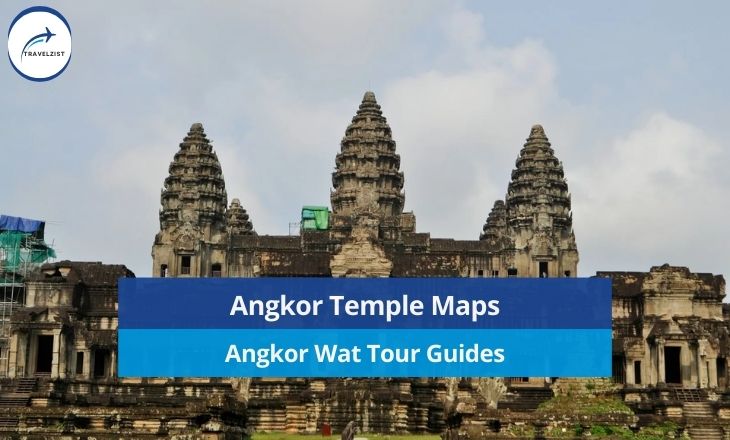This comprehensive travel guide not only unveils the secrets and legends shrouding this UNESCO World Heritage Site but also provides you with valuable insights on how to navigate through its vast expanse with ease.
But navigating through the vast expanse of Angkor can be overwhelming without a guide, which is where Angkor Wat Cambodia temple Maps and the expert tour guides of Siem Reap come to your rescue.
Embark on a journey like no other as we unravel the secrets of these sacred grounds, guiding you through centuries-old mysteries and architectural marvels that continue to captivate travelers from around the globe.
What Is Angkor Wat Cambodia? What Is The History?
Angkor Wat Cambodia Temple, a magnificent temple complex built by the Khmer empire in the 12th century, spans over 160 hectares of land in Cambodia. This architectural marvel was constructed with the help of an impressive workforce of 300,000 workers and 6,000 elephants.
Originally dedicated to Hindu gods, Angkor Wat later transitioned into a Buddhist temple. However, despite its grandeur, the site has suffered significant damage over centuries from earthquakes, looting, and wars.
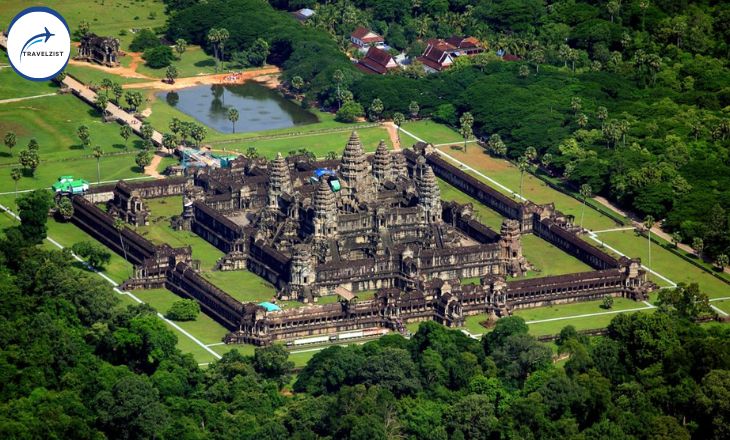
Today, what remains of Angkor Wat are striking ruins that continue to captivate visitors from around the world. Designated as a UNESCO World Heritage site, Angkor Wat attracts millions of tourists annually who come to witness firsthand the beauty and historical significance of this ancient temple complex.
Its intricate architecture and rich cultural heritage make it a must-visit destination for history enthusiasts and travelers alike.
Where Is Angkor Wat Combodia Temple Located?
Located in Cambodia, Angkor Wat is a historic temple complex built by the Khmer empire in the 12th century. Encompassing an impressive 160 hectares, it was initially constructed as a Hindu temple but later evolved into a Buddhist site. The immense scale of the project is evidenced by the use of 300,000 workers and 6,000 elephants during its construction.

Despite enduring damage from earthquakes, looting, and wars over the centuries, Angkor Wat remains a captivating symbol of ancient architecture. Its weathered but majestic ruins draw millions of tourists annually to marvel at its intricate carvings and grandiose structure. Today, designated as a UNESCO World Heritage site, Angkor Wat stands as a testament to the rich cultural heritage of Southeast Asia.
Best Angkor Wat Tours
Klook provides a variety of day tours in Siem Reap, with prices starting at just $12 USD. For those looking to experience the iconic Angkor Wat at sunrise in a private setting, a tuk-tuk tour can be booked for $19 USD. Alternatively, a more budget-friendly option is the shared sunrise tour, available for just $12 USD.
With its convenient booking platform and excellent customer reviews, Klook is highly recommended by travelers globally for its range of tour options. Whether you’re interested in exploring historical sites, sampling local cuisine, or embarking on thrilling adventures, Klook offers something for everyone. Booking with Klook ensures a hassle-free experience with knowledgeable guides and reliable transportation services.
Angkor Wat Map For Cambodia
The temples of Angkor on map are located approximately 6.3 kilometers from the town of Siem Reap in Cambodia. The sprawling complex is home to numerous ancient structures and ruins, offering visitors a glimpse into Cambodia’s rich history and culture.
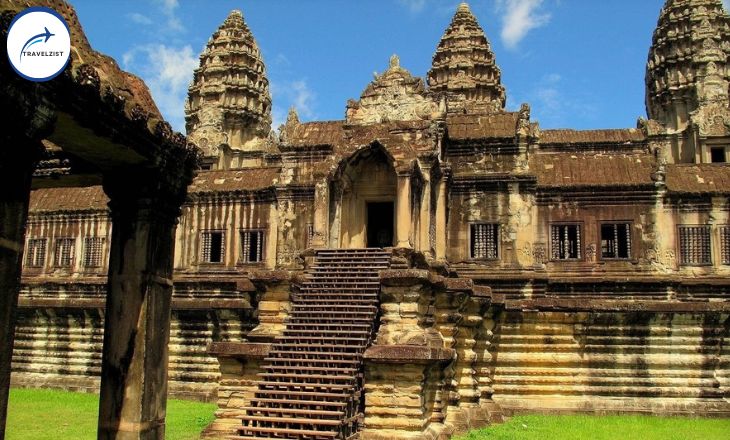
Within the Angkor park, visitors can find various food and drink shacks where they can refuel and stay energized throughout their exploration. It is recommended to stay hydrated, especially during popular times such as rush hours to catch the sunrise at iconic spots within the temple complex.
To prepare for the early morning start, it’s advisable to bring a reusable water bottle to ensure you have access to water as you navigate through the temples and grounds of Angkor Wat. Remember to pace yourself and take breaks as needed, allowing for a more enjoyable and immersive experience at this remarkable historical site.
Visiting The Angkor Wat Temples
Angkor Wat tours typically begin at the ticket office, allowing visitors the opportunity to explore the magnificent temple complex. Many choose to witness the stunning sunrise over Angkor Wat before embarking on either the small or grand circuit tours. Tourists have the option of traveling by car or tuk-tuk, each with its own advantages and drawbacks; while cars offer more comfort, tuk-tuks provide a more immersive experience.
It is advisable to bring $1 bills when visiting Angkor Wat, as there are drink stands along the way where you can purchase refreshments to stay hydrated in the Cambodian heat. Walking in this hot weather can be demanding, so it’s essential to carry water and take breaks when needed.
Hours of Entry
- Angkor Ticket Office: 5 AM – 5:30 PM
- Angkor Wat: 5 AM – 5:30 PM
- Phnom Bakheng & Pre Rup: 5 AM – 7 PM
- All Other Temples: 7:30 AM – 5:30 PM
Tickets & Entrance Fees
In 2020, the Angkor Wat entry fees vary based on the duration of stay. Visitors can opt for a single-day pass priced at $37 USD, a three-day pass at $62 USD, or a seven-day pass at $72 USD. Notably, children under 12 years old and Cambodian citizens are granted free entrance. It’s worth mentioning that the current fees were doubled in 2017, which is perceived as high by local standards.

When it comes to payment options, visitors have the convenience of paying with cash in multiple currencies or using various credit card providers. The availability of these payment methods adds flexibility for travelers from different regions.
Ticket Durations
The 1-day ticket is only valid on the day of purchase and cannot be used on a future date. The 3-day ticket, visitors have the flexibility to choose their visit dates within a 10-day period from the date of purchase.
For those planning multiple visits or wanting to spread out their experience, the 7-day ticket allows patrons to select any 7 days within a month for entry. This option provides more freedom and convenience in scheduling visits. It’s important to note that once a day is used on any ticket, it counts as one day off the total allowance, so plan accordingly.
Dress Code
Visitors are required to adhere to a dress code that mandates modest attire when entering the temple grounds. This means clothing should cover both knees and shoulders in order to show respect for the sacred site.
While the rules require conservative dressing, visitors can wear shorts as long as they reach below the knees. By respecting these guidelines, visitors demonstrate their understanding and appreciation of the religious significance of Angkor Wat.
By following these dress code regulations, visitors contribute to maintaining the sanctity and reverence of this iconic temple complex.
Sunrise At The Angkor Wat
Angkor Wat tours commonly kick off with a captivating sunrise viewing at the ancient temples, making for a magical experience despite the crowds.
It is highly recommended to witness this spectacle firsthand, as it offers a truly breathtaking sight that is revered worldwide. Detailed mini-guides are readily available to help you navigate the best photo spots and provide useful access tips for capturing the perfect moment.
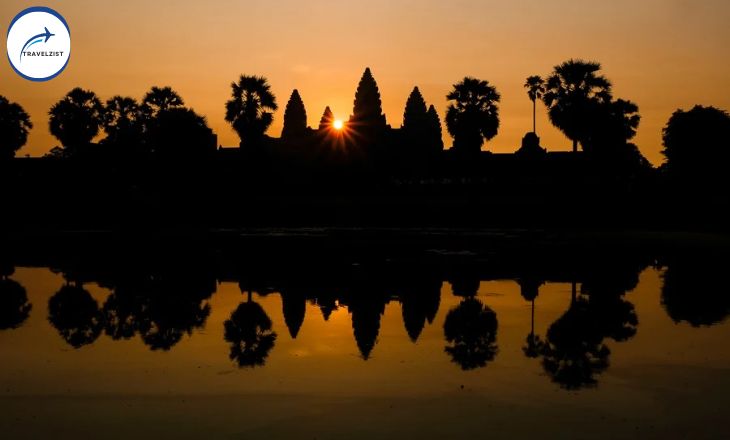
The main Cambodian temple serves as a stunning backdrop as the sun rises behind it, creating an enchanting scene that is sure to leave a lasting impression. This iconic location has become synonymous with its spectacular sunrise views, drawing in visitors from all corners of the globe seeking to witness its beauty firsthand.
Be prepared to wake up early and join the throngs of tourists eager to witness this remarkable event, but rest assured that the experience will be well worth it.
Angkor Wat Small Circuit vs Grand Circuit
Angkor Wat offers two main tour circuits for visitors to explore the small circuit and the grand circuit.
The small circuit includes the famous Tomb Raider temple, Ta Prohm, known for its enchanting tree roots intertwined with ancient ruins.
The grand circuit also features notable attractions such as Preah Khan and Neak Pean temples.
Both circuits can be thoroughly explored in a single day, providing an immersive experience of the ancient temples and their intriguing histories. To make your decision easier, consider the highlights of each circuit and choose based on your interests and time constraints.
Small Circuit – Things To See
One of the main attractions is the intricate network of electrical components that make up the circuit board. You can observe resistors, capacitors, transistors, and other components working together to facilitate the flow of electricity.
Angkor Wat Temple
Angkor Wat temple serves as the starting point for both small and grand circuits, offering visitors a glimpse of its awe-inspiring sunrise and colossal size. As one of the UNESCO World Heritage Sites, this ancient temple complex is a must-see attraction in Cambodia.
Visitors are advised to allocate at least an hour to explore the intricate details and historical significance of Angkor Wat. The small circuit includes major temples like Ta Prohm and Bayon, showcasing exquisite Khmer architecture and intricate carvings.
Baksei Chamkrong
Located near Angkor Thom in Cambodia’s temple complex is a small and lesser-known pyramid temple that is often not included in regular tours. This hidden gem is tucked away amidst the lush jungle, offering visitors a unique and tranquil experience away from the crowds.
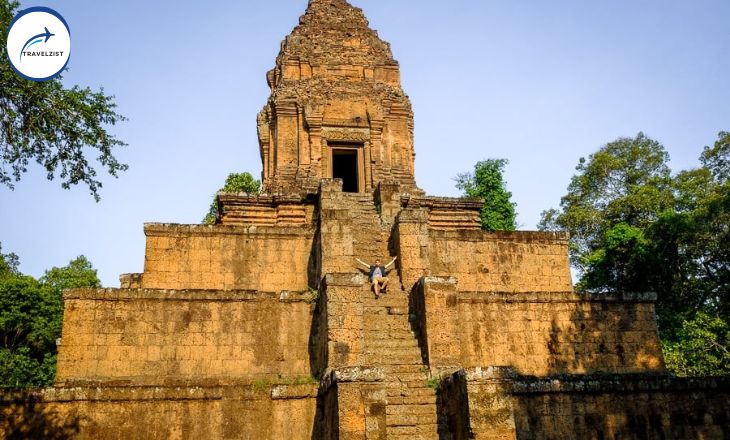
The temple features intricate carvings and architecture characteristic of the Khmer empire, providing a glimpse into Cambodia’s rich history and culture. Despite its modest size, the temple exudes an air of mystery and intrigue, inviting exploration and discovery.
Angkor Thom Gate
The Angkor Thom Gate, located in the south entrance of the Angkor Thom temple complex in Cambodia, serves as a grand entryway to this historical site. Despite its current poor condition, the gate’s intricate architecture and towering structure still captivate visitors from around the world. The gate is adorned with large stone faces on each side, representing different deities from Hindu mythology.
Bayon
Bayon is a remarkable temple situated within the Angkor Thom complex in Cambodia. It is renowned for its intricately carved walls, showcasing impressive bas-reliefs depicting historical and mythological scenes. One of the most iconic features of Bayon is the multitude of serene stone faces that adorn its towers, capturing the attention of visitors and photographers alike.
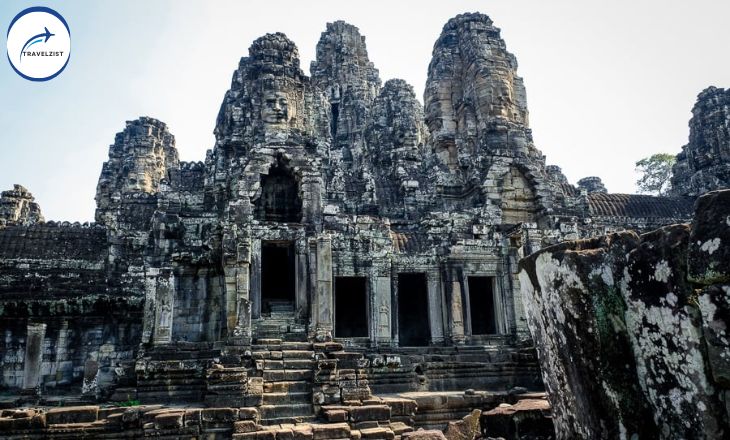
The temple was constructed in the late 12th century by King Jayavarman VII, reflecting a unique blend of Hinduism and Buddhism in its architecture and decorations. The intricate carvings on the temple’s walls provide glimpses into daily life, battles, and ancient religious practices.
Thommanon
Thommanon is a hidden gem tucked away within the grand complex of Angkor Thom in Cambodia. While not as famous as its neighboring temples, Thommanon boasts stunning intricate carvings and elaborate doorways that showcase exquisite craftsmanship.
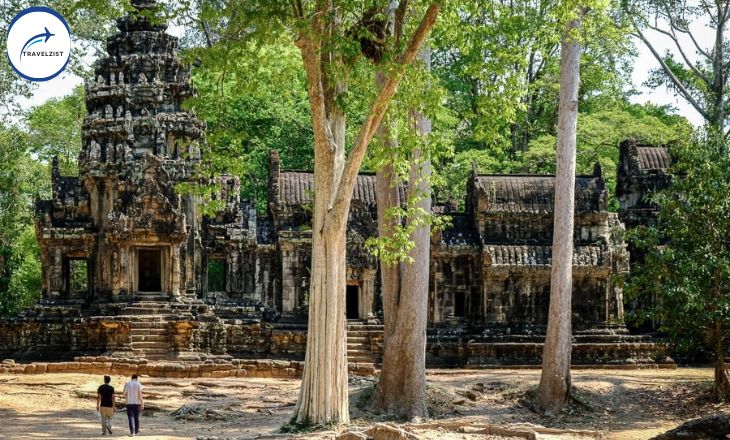
Tour groups often tend to overlook this temple, making it a perfect destination for those seeking a more intimate and peaceful experience. Visitors to Thommanon can marvel at the well-preserved sandstone structures that date back to the 12th century Khmer empire.
Ta Prohm
Ta Prohm is a renowned temple in Cambodia that gained worldwide fame for its appearance in the movie Tomb Raider starring Angelina Jolie. One of the most striking features of Ta Prohm is the sight of a large tree growing on top of a ruined building, creating a captivating blend of nature and ancient architecture.
This temple showcases the unique beauty of nature reclaiming man-made structures over time, making it a popular spot for photographers and adventurers alike.
Banteay Kdei
Banteay Kdei, located within the ancient temple complex of Angkor Wat in Cambodia, is renowned for its breathtaking sight of massive tree roots engulfing temple buildings. These majestic trees have become a prominent feature of the architectural landscape, their sprawling roots winding around the walls and towers of the temple.
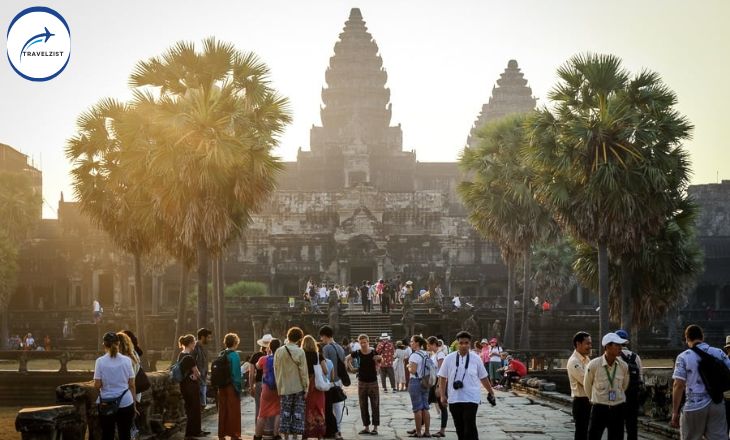
Over time, the relentless growth of these trees has led to an entwining with the structures, creating a stunning fusion of nature and man-made architecture. Visitors are often awe-struck by the sheer size and strength of these tree roots that seem to be reclaiming the temples back into the embrace of the surrounding jungle.
Grand Circuit – Things To See
These are following things to see.
Angkor Wat
Angkor Wat, the main temple in the Angkor complex, is a magnificent structure that serves as the starting point for both the small and grand circuits. Visitors flock to witness the epic sunrise view over this ancient wonder before embarking on their exploration. Standing tall and imposing, Angkor Wat showcases intricate carvings and stunning architecture that tell stories of Cambodia’s history and culture.
Preah Khan
The Preah Khan temple, located on the Grand Circuit in Cambodia, stands as a testament to the passage of time with much of its structure now in ruins. Nature has begun to reclaim the ancient temple, intertwining vegetation with the stone remnants.
Despite its deteriorated state, the site remains a favorite stop for visitors due to its unique blend of nature and ancient architecture.
Neak Pean
Neak Pean is an ancient temple located on a small island within a serene pond in Cambodia. The temple’s beauty is truly magnified after the rainy season, when the pond is full of water, creating a picturesque reflection that enhances the overall spiritual experience.
Visitors can witness the temple appearing as if it is floating on the water, surrounded by lush greenery and a tranquil ambiance. However, during the dry season, the water levels in the pond decrease significantly, altering the landscape and possibly impacting the visual appeal of Neak Pean.
Ta Som
Located in the Grand Circuit of Angkor Wat, Ta Som temple is a small but intriguing historical site that stands out for its unique natural feature. The temple’s entrance is adorned with a stone doorway that is entwined by the roots of a strangler fig tree, creating a striking and picturesque sight for visitors.
This symbiotic relationship between man-made structure and nature adds to the charm and mystique of Ta Som temple.
East Mebon
The East Mebon temple in Cambodia is noted for its lack of preservation compared to other temples in the area. Despite this, one of its most striking features is the presence of elephant statues at each corner of the temple. These statues are intricately carved and symbolize strength and power in Cambodian culture.
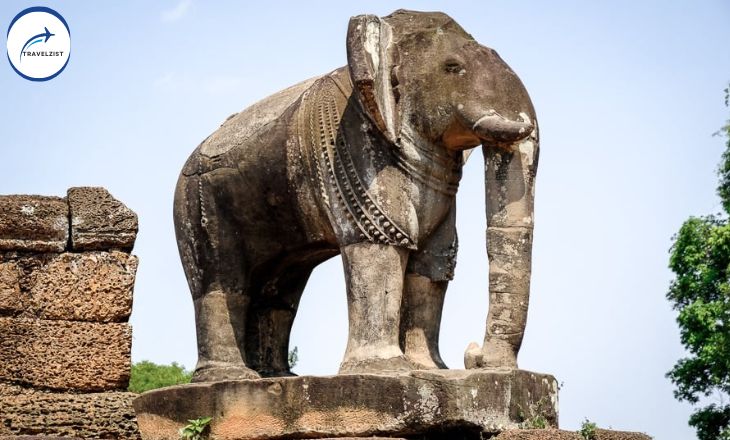
Originally constructed by King Rajendravarman II in the 10th century, the temple was dedicated to the Hindu god Shiva. The structure consists of three tiers and offers panoramic views of the surrounding countryside from its upper levels.
Pre Rup
Pre Rup temple is located near the famous Angkor Wat in Cambodia’s grand circuit. This ancient structure was primarily used for funeral ceremonies, lending it a somewhat eerie and solemn ambiance.
One of the main attractions of Pre Rup temple is its well-preserved buildings situated at the top of the pyramid, making it a popular destination for tourists and history enthusiasts alike.
The intricate carvings and detailed architectural features showcase the skill and craftsmanship of the Khmer Empire builders. Visitors can climb to the summit for panoramic views of the surrounding jungle and temples.
Beyond Angkor Wat – More Temples To See
There are following temples to see.
Koh Ker Temple
Located near Siem Reap, Koh Ker Temple is a fascinating temple group that offers a remote and serene escape for visitors. The journey to reach this site involves a scenic 2.5-hour drive through the Cambodian countryside, adding to the sense of adventure.
The main attraction at Koh Ker is the impressive 7-tier pyramid structure, shrouded by forest greenery, giving it an air of mystery and ancient nobility.
Prasat Pram Temple
Prasat Pram Temple is a fascinating attraction located within the Koh Ker area of Cambodia. This ancient temple is particularly notable for its unique feature of being gradually overtaken by strangler trees, adding to its mysterious and enchanting ambiance.
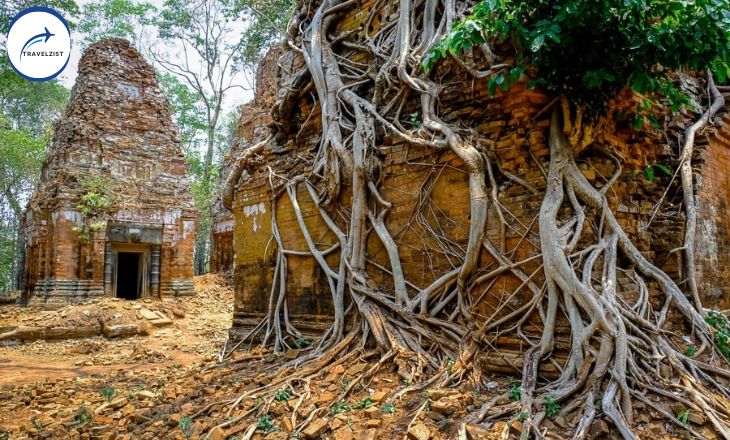
Many visitors opt to take a day trip from nearby Siem Reap to explore this hidden gem. Despite its relatively remote location, Prasat Pram Temple has gained popularity among tourists and is often considered a favorite destination after the iconic Angkor Wat.
Bantei Srei Temple
Located just a 1-hour drive away from Siem Reap, the stunning Banteay Srei Temple is renowned for its captivating red sandstone hues. This temple stands out for its exquisite stone carvings, widely considered to be among the finest in Khmer architecture. Visitors have the option to combine a visit to Banteay Srei with a small circuit tour by arranging additional payment for their driver.
Beng Mealea
Beng Mealea temple is located about 1.5 hours away from Siem Reap, making it a popular destination that is often combined with a visit to Koh Ker. The temple’s remote location creates an off-the-beaten-path experience for visitors seeking a more secluded and authentic exploration of ancient ruins. This captivating sight gives the temple a romantic, mysterious atmosphere that attracts photographers and adventurers alike.
Roluos Group
Located just a 30-minute drive away from Siem Reap lies the Roluos Group temples, making them an ideal destination for a day trip. These ancient structures date back to the 9th century and are considered among Cambodia’s oldest Khmer temples.
The temples of Roluos Group consist of three main temples: Bakong, Lolei, and Preah Ko, each showcasing intricate carvings and unique architectural features.
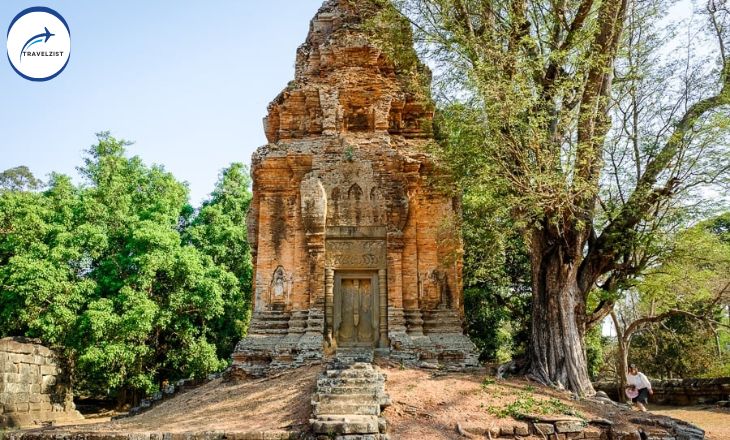
Hotels At The Angkor Wat
Siem Reap is a town located near the famous Angkor Wat temple complex, making it a convenient and strategic location for visitors to book a hotel. The town boasts a variety of affordable options for dining, accommodation, and relaxation services such as massage places.
Travelers can enjoy exploring the ancient ruins of Angkor Wat during the day and return to Siem Reap in the evening to unwind with a delicious meal or a soothing massage without breaking the bank.
Angkor Wat Itinerary
For a comprehensive 4-day Angkor Wat itinerary in Siem Reap, Cambodia, visitors can make the most of their time by following this suggested schedule.
- On Day 1, start with the iconic Angkor Wat sunrise followed by exploring the small circuit of temples. Day 2 can be dedicated to the grand circuit of Angkor Wat, allowing for a deeper immersion into the ancient architecture and history.
- Day 3 offers a unique experience with a day trip to the Koh Ker temples, providing a glimpse into lesser-known archaeological treasures
- Day 4, visitors can unwind and explore the charming Siem Reap town, engaging in activities such as temple visits, dining at local restaurants, and shopping for souvenirs. This itinerary offers a well-rounded exploration of both historical sites and modern amenities in this vibrant city.
Is Cambodia Safe?
Cambodia is generally considered safe for tourists, with a low crime rate compared to other countries in the region. However, it is important to exercise caution and be aware of your surroundings, especially in crowded areas and tourist spots where pickpocketing can occur.
It is also advisable to be cautious when using public transportation and avoid walking alone at night in unfamiliar or poorly lit areas.
Conclusion
Angkor Wat Cambodia Temple is a remarkable destination that offers visitors a unique opportunity to explore the rich history and architectural wonders of ancient Khmer civilization.
With its intricate carvings, towering spires, and expansive grounds, this UNESCO World Heritage Site is a must-visit for anyone interested in history, culture, or architecture. Navigating the temple complex with the help of a detailed Angkor wat on a map can enhance your experience and ensure you don’t miss any important sites.
Remember to respect the sacred nature of the temple and follow local customs during your visit. Plan your trip to Angkor Wat today and embark on an unforgettable journey through one of the world’s most impressive historical sites.
FAQs
What is the Best Way to Explore Angkor Wat?
The best way to explore Angkor Wat, the largest religious monument in the world, is by starting early in the morning to avoid crowds and witness the magnificent sunrise over the temple complex. Hiring a knowledgeable guide or joining a guided tour can provide valuable insights into the history and significance of each temple within the Angkor Archaeological Park.
Do you Need a Tour Guide at Angkor Wat?
While it is not mandatory to have a tour guide when visiting Angkor Wat, having one can greatly enhance your experience at the ancient temple complex. A knowledgeable guide can provide valuable insights into the history, architecture, and significance of the various temples within Angkor Wat.
How Many Days do You Need to Visit Angkor Wat?
The recommended duration for visiting Angkor Wat and its surrounding temples is typically 3-4 days. This allows visitors to explore the main temple complex of Angkor Wat itself, as well as other significant sites such as Bayon, Ta Prohm, and Banteay Srei.
- El Nido Palawan Island Travel Guide For The Philippines - 29 May 2024
- Uluwatu Bali: 20 Best Things To Do In Uluwatu - 28 May 2024
- Breckenridge Troll Hike: Isak Heartstone Location & Directions - 24 May 2024

